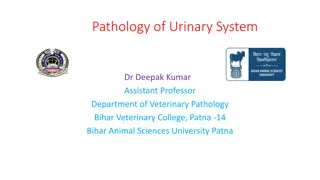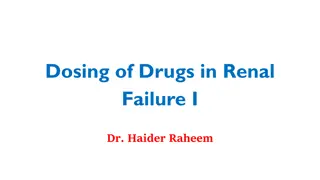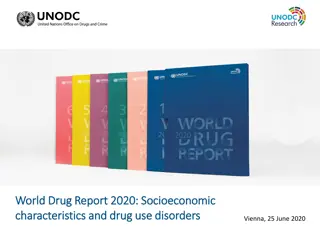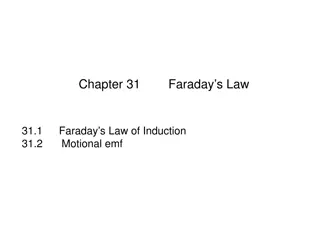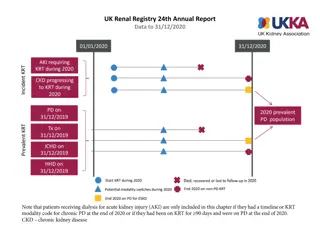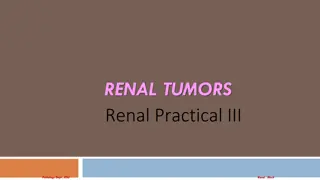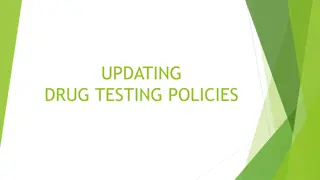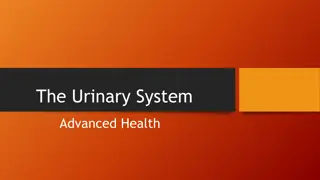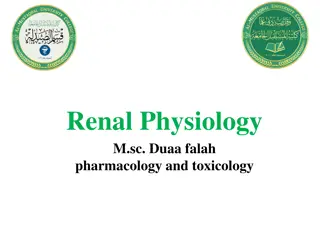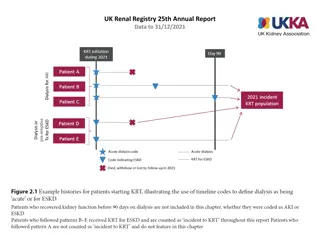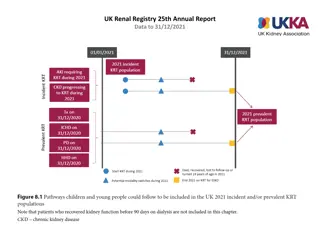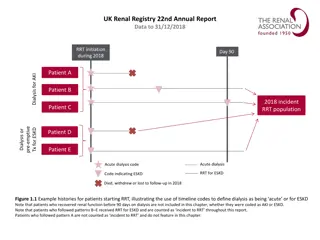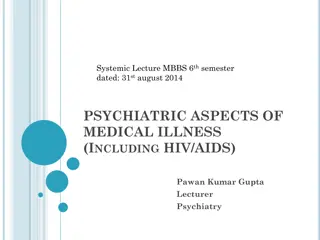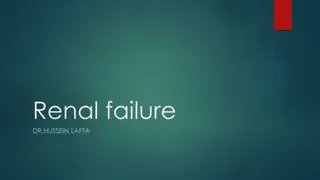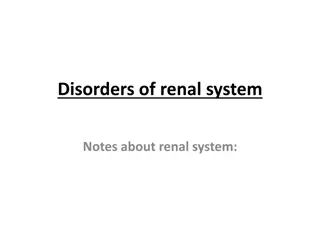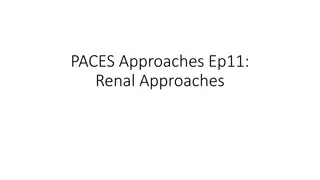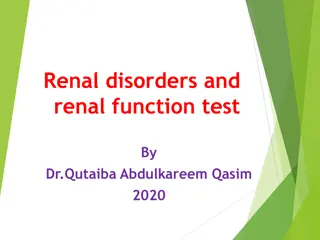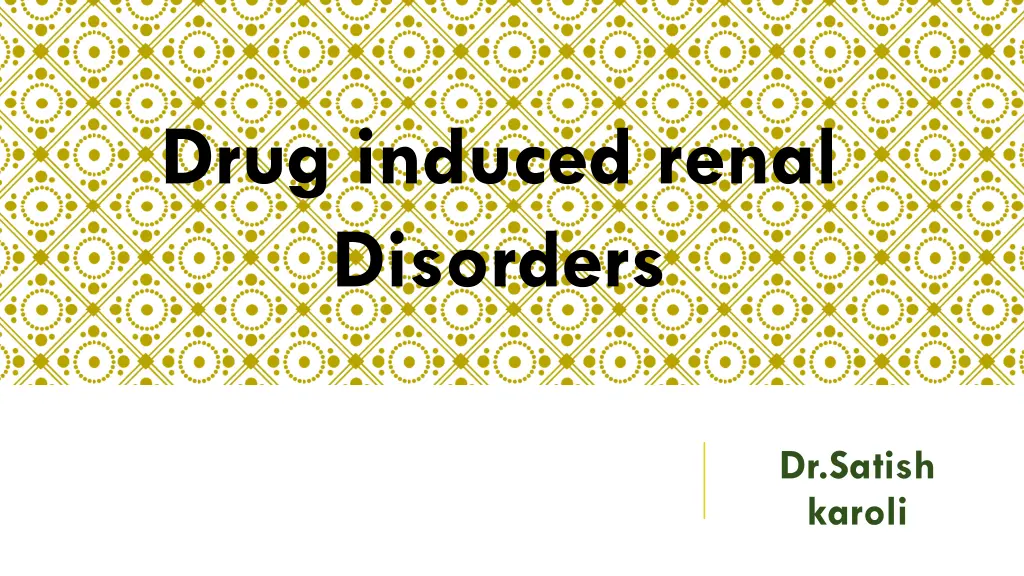
Understanding Drug-Induced Kidney Disease (DIN) and Renal Disorders
Explore the manifestations, diagnosis, and management of Drug-Induced Kidney Disease (DIN) in this comprehensive overview. Learn about its reversible nature, incidence patterns, risk factors, and preventive measures. Stay informed to protect kidney health!
Download Presentation

Please find below an Image/Link to download the presentation.
The content on the website is provided AS IS for your information and personal use only. It may not be sold, licensed, or shared on other websites without obtaining consent from the author. If you encounter any issues during the download, it is possible that the publisher has removed the file from their server.
You are allowed to download the files provided on this website for personal or commercial use, subject to the condition that they are used lawfully. All files are the property of their respective owners.
The content on the website is provided AS IS for your information and personal use only. It may not be sold, licensed, or shared on other websites without obtaining consent from the author.
E N D
Presentation Transcript
Drug induced renal Disorders Dr.Satish karoli
Drug-induced Kidney Disease or Nephrotoxicity (DIN) Drug-induced kidney disease or nephrotoxicity (DIN) is a relatively common complication of several diagnostic and therapeutic agents. It is seen in both inpatient and outpatient settings with variable presentations depending on the drug and clinical setting.
Manifestations of DIN include : Acid base abnormalities Electrolyte imbalances Urine sediment abnormalities, Proteinuria Pyuria, and/or Hematuria
However, the most common manifestation of DIN is a decline in the glomerular filtration rate (GFR), which results in a rise in the serum creatinine (Scr) and blood urea nitrogen (BUN). Initial diagnosis of DIN is often delayed as it typically involves detection of elevated Scr and BUN, for which there is a temporal relationship between the toxicity and use of a potentially nephrotoxic drug. This is consistent with the classic qualitative definition of acute renal failure (ARF) i.e., an abrupt and sustained decrease in glomerular filtration, urine output, or both.
Unfortunately, numerous definitions of ARF and nephrotoxicity based on various quantitative changes in the serum creatinine concentration and other clinical end points have been published. Consequently, it is extraordinarily difficult to ascertain the true incidence of ARF and/or DIN because broad ranges have been reported for the same agent. This may be alleviated if the recently developed new diagnostic criteria based on physiologic measurements (e.g., Scr and urine output) are broadly accepted, and if the new term acute kidney injury (AKI) supplants the use of ARF.
DIN is often reversible on discontinuation of the offending agent, but may also lead to acute kidney injury and/or end-stage renal disease (ESRD). Currently, many different mechanisms are responsible for the pathogenesis of DIN and the introduction of new drugs with novel mechanisms of action provides the potential for the identification of new presentations of AKI and chronic kidney disease (CKD). This chapter reviews the epidemiology, pathophysiology, risk factors, and basic principles of prevention of DIN. Detailed discussions of these issues plus management strategies are presented for widely used agents that have been associated with a moderate to high likelihood of DIN
EPIDEMIOLOGY The incidence and characteristics of outpatient or community acquired DIN are not well understood as mild toxicity is often unrecognized in this setting. However, the pharmacoepidemiology of these effects has become more important as care increasingly shifts to the outpatient setting. Up to 20% of hospital admissions, as a result of AKI, have been attributed specifically to community acquired DIN.
Conversely, DIN has been studied for years in the acute care hospital setting where it has been implicated in 8% to 60% of all cases of in-hospital AKI and as such is a recognized source of significant morbidity and mortality. In-hospital drug use may contribute to 35% of all cases of acute tubular necrosis, most cases of allergic interstitial nephritis (AIN), as well as nephrotoxicity due to alterations in renal hemodynamics and postrenal obstruction.
The incidence of antibiotic-induced nephrotoxicity alone may be as high as 36%.1 Aminoglycoside antibiotics, radiocontrast media, conventional nonselective nonsteroidal anti inflammatory drugs (NSAIDs) and selective cyclooxygenase-2 (COX-2) inhibitors, amphotericin B, and angiotensin-converting enzyme inhibitors (ACEIs) have also been frequently implicated. Computerguided medication dosing for hospital inpatients may improve the safety of some of these potentially harmful drugs and minimize the occurrence of DIN in this setting.
CLINICAL PRESENTATION In-hospital drug use may contribute to 35% of all cases of acute tubular necrosis, most cases of allergic interstitial nephritis (AIN), as well as nephrotoxicity due to alterations in renal hemodynamics and postrenal obstruction. The incidence of antibiotic-induced nephrotoxicity alone may be as high as 36%. Aminoglycoside antibiotics, radiocontrast media, conventional nonselective nonsteroidal anti inflammatory drugs (NSAIDs) and selective cyclooxygenase-2 (COX-2) inhibitors, amphotericin B, and angiotensin-converting enzyme inhibitors (ACEIs) have also been frequently implicated.
Computer guided medication dosing for hospital inpatients may improve the safety of some of these potentially harmful drugs and minimize the occurrence of DIN in this setting.
CLINICAL PRESENTATION OF DRUG-INDUCED KIDNEY DISEASE General: The most common manifestation is a decline in GFR leading to a rise in Scr and BUN. Symptoms: Malaise, anorexia, vomiting, shortness of breath, or edema.
Signs : Decreased urine output may be an early sign of toxicity, particularly with radiographic contrast media, NSAIDs, and ACEIs, with progression to volume overload and hypertension. Proximal tubular injury: metabolic acidosis with bicarbonaturia; glycosuria in the absence of hyperglycemia; and reductions in serum phosphate, uric acid, potassium, and magnesium as a result of increased urinary losses. Distal tubular injury: polyuria from failure to maximally concentrate urine, metabolic acidosis from impaired urinary acidification, and hyperkalemia from impaired potassium excretion
Laboratory Tests A change in Scr of at least 0.5 mg/dL for subjects with a baseline Scr 30% for those with Scr >2 mg/dL, when correlated temporally with the initiation of drug therapy is commonly observed.
Other Diagnostic Tests: Urinary excretion of N-acetyl- -D-glucosaminidase, -glutamyl transpeptidase, glutathione S-transferase, and interleukin-18 are markers of proximal tubular injury and have been used for the early detection of AKI in critically ill patients. Kidney injury molecule-1 (KIM-1) is expressed in the proximal tubule and is upregulated in patients with ischemic acute tubular necrosis, appearing in the urine within 12 hours after the ischemic insult. Neutrophil gelatinase-associated lipocalin (NGAL) protein may be detected in the urine within 3 hours of ischemic injury.
TABLE 49-1 Drug-Induced Renal Structural Functional Alterations Tubular epithelial cell damage Acute tubular necrosis Pentamidine Adefovir, cidofovir, tenofovir Radiographic contrast media Aminoglycoside antibiotics Zoledronate Amphotericin B Osmotic nephrosis Cisplatin, carboplatin Dextran Cyclosporine, tacrolimus Intravenous immunoglobulin Foscarnet Mannitol
Tubulointerstitial disease Acute allergic interstitial nephritis Nephrocalcinosis Ciprofloxacin Oral sodium phosphate solution Loop diuretics Papillary necrosis Nonsteroidal cyclooxygenase-2 inhibitors Nonsteroidal combined phenacetin, aspirin, and Penicillins caffeine analgesics Proton pump inhibitors Chronic interstitial nephritis Cyclosporine Lithium Aristolochic acid anti-inflammatory drugs, anti-inflammatory drugs,
Nephrotoxicity may be evidenced by alterations in renal tubular function without loss of glomerular filtration. Indicators of proximal tubular injury include metabolic acidosis with bicarbonaturia; glycosuria in the absence of hyperglycemia; and reductions in serum phosphate, uric acid, potassium, and magnesium as a result of increased urinary losses. Indicators of distal tubular injury include polyuria from failure to maximally concentrate urine, metabolic acidosis from impaired urinary acidification, and hyperkalemia from impaired potassium excretion. Urinary enzymes and low-molecular-weight proteins are also used as early markers of nephrotoxicity.
For example, urinary excretion of Nacetyl--D-glucosaminidase, -glutamyl transpeptidase, glutathione S-transferase, and interleukin-18 are markers of proximal tubular injury and have been used for the early detection of acute kidney damage in critically ill patients. The transmembrane protein KIM-1 is expressed in the proximal tubule and is upregulated in patients with ischemic acute tubular necrosis, appearing in the urine within 12 hours after the ischemic insult. Similarly, NGAL protein is detected in the urine within 3 hours of ischemic injury in rodent models of kidney disease. In the future, novel urinary biomarkers such as interleukin-18, KIM-1, and NGAL may facilitate the earlier diagnosis of nephrotoxicity and minimize the long-term consequences of this common drug-induced disorder
PRINCIPLES FOR PREVENTION OF DRUG-INDUCED NEPHROPATHY The primary principle for prevention of DIN is to avoid the use of potentially nephrotoxic agents in patients at increased risk for toxicity. However, because exposure to these drugs often cannot be avoided, several interventions have been proposed to reduce the potential for the development of nephrotoxicity, for example, careful and adequate hydration to establish high renal tubular urine flow rates. However, other strategies to reduce drug toxicity are still theoretical and/or investigational and relate directly to the specific nephrotoxic mechanisms of the drug. For example, adefovir is a nucleotide antiviral that is actively transported by OAT1. Inhibition of OAT1-mediated transport with NSAIDs minimizes accumulation of adefovir in renal proximal tubule cells and results in a reduction in DIN.
TUBULAR EPITHELIAL CELL DAMAGE Renal tubular epithelial cell damage may be caused by either direct toxic or ischemic effects of drugs. Damage is most often localized in the proximal and distal tubular epithelia, and when observed as cellular degeneration and sloughing from proximal and distal tubular basement membranes is termed acute tubular necrosis. Swelling and vacuolization of proximal tubular cells may also be noted in those with osmotic nephrosis. Acute tubular necrosis is the most common presentation of DIN in the inpatient setting. The primary agents implicated in renal tubular epithelial cell damage are aminoglycosides, radiocontrast media, cisplatin, amphotericin B, foscarnet, and osmotically active agents such as immunoglobulins, dextrans, and mannitol.
ACUTE TUBULAR NECROSIS Aminoglycoside Nephrotoxicity Incidence Although nephrotoxicity has been reported in up to 58% of patients who are receiving aminoglycoside therapy, most recent reviews suggest rates of 5% to 15%. The large variance is in part a result of the use of different definitions of toxicity, variability between agents in the class, and the risk factors present in the study population.
Clinical Presentation A gradual progressive rise in the serum creatinine concentration and decrease in creatinine clearance after 6 to 10 days of therapy are the initial clinical manifestations of toxicity. Patients typically present with nonoliguria, maintaining urine volumes greater than 500 mL/day. Although renal magnesium wasting can occur, that is, daily excretion of more than 10 to 30 mg, the risk of hypomagnesemia is generally low. Severe kidney injury does not usually develop if aminoglycoside therapy is stopped promptly upon notation of a signficant rise in serum creatinine, but occasionally it may, and for these individuals dialysis therapy may be required.
Aminoglycoside-associated nephropathy must be evaluated carefully because not all AKI during a course of therapy is caused by the aminoglycoside. Dehydration, sepsis, ischemia, and other nephrotoxic drugs frequently contribute to and complicate the identification of the causative agent or condition.
Pathogenesis The reduction of GFR in patients receiving aminoglycosides is predominantly the result of proximal tubular epithelial cell damage leading to obstruction of the tubular lumen and back leakage of the glomerular filtrate across the damaged tubular epithelium. Toxicity may be related to cationic charge, which facilitates binding of filtered aminoglycosides to renal tubular epithelial cell luminal membranes, followed by intracellular transport and concentration in lysosomes. Cellular dysfunction and death may result from release of lysosomal enzymes into the cytosol, generation of reactive oxygen species, altered cellular metabolism, and alterations in cell membrane fluidity, leading to reduced activity of membrane-bound enzymes, including Na+-K+- adenosine triphosphatase, dipeptidyl peptidase IV, and neutral aminopeptidase.
Risk Factors Multiple risk factors for aminoglycoside nephrotoxicity have been identified. These relate to the aggressiveness of aminoglycoside dosing, synergistic toxicity as the result of combination drug therapy, and preexisting clinical conditions of the patient.
Prevention Aminoglycoside-induced nephrotoxicity may be prevented by more discriminating selection of patients in whom the drugs are used. Moreover, alternative antibiotics should be used whenever possible and as soon as microbial sensitivities are known. Commonly used alternatives include fluoroquinolones (e.g., ciprofloxacin or levofloxacin) and third- or fourth-generation cephalosporins (e.g., ceftazidime or cefepime). When aminoglycosides are necessary, the specific drug used does not appear to significantly affect the risk of nephrotoxicity, and therapy should be selected to optimize
Furthermore, it is imperative to avoid volume depletion, limit the total aminoglycoside dose administered, and avoid concomitant therapy with other nephrotoxic drugs. Future therapeutic alternatives may include nonnephrotoxic aminoglycoside congeners, which are in development, that retain the desired bactericidal activity and yet are devoid of nephrotoxicity.
Prospective, individualized pharmacokinetic monitoring has been used for more than 25 years. Although many have reported a decrease in the incidence of aminoglycoside-induced nephrotoxicity, the studies are often small and statistically underpowered. High intermittent dosing of aminoglycosides, termed once-daily dosing, used in combina Prospective, individualized pharmacokinetic monitoring has been used for more than 25 years. Although many have reported a decrease in the incidence of aminoglycoside-induced nephrotoxicity, the studies are often small and statistically underpowered. High intermittent dosing of aminoglycosides, termed once-daily dosing, used in combina
Management Serum creatinine concentrations should be measured frequently (every 2 to 4 days) during therapy. Aminoglycoside use should be discontinued or the dosage regimen revised if a Scr increase of 0.5 mg/dL or more is noted that is not attributable to another cause. Other nephrotoxic drugs should be discontinued if possible, and the patient should be maintained adequately hydrated and hemodynamically stable. Short-term dialysis may be necessary, but ESRD has rarely been reported to be solely the result of aminoglycoside toxicity
Radiographic Contrast Media Nephrotoxicity Incidence Nephrotoxicity associated with radiographic contrast media administration is the third leading cause of hospital-acquired AKI. The incidence rises from <2% in patients with a low risk of AKI to 40% to 50% in patients with a high risk, such as those with CKD or diabetes mellitus. The risk of contrast-induced nephrotoxicity increases as the number of risk factors increases, and diabetic patients with CKD have the greatest risk.
Clinical Presentation Contrast nephrotoxicity presents most commonly as nonoliguric, transient tubular enzymuria. However, irreversible oliguric (urine volume <500 mL/day) kidney injury requiring dialysis has been reported in high-risk patients. Kidney injury typically manifests within the first 12 to 24 hours after the administration of contrast. The serum creatinine concentration usually peaks between 2 and 5 days after exposure, with recovery after 4 to 10 days.
Urinalysis typically reveals only hyaline and granular casts, but may also be completely bland. The urine sodium concentration and fractional excretion of sodium are frequently low. Although toxicity has generally been considered to be mild and reversible, an in- hospital mortality rate of 35% has been reported in patients with severe contrast media- induced AKI requiring dialysis, compared to 7% in those with contrast nephrotoxicity not requiring dialysis.
Pathogenesis Contrast nephrotoxicity appears to be caused by direct tubular toxicity and/or renal ischemia. Direct tubular toxicity is suggested by the frequent presence of renal tubular enzymuria and biopsy findings of proximal tubular epithelial cell vacuolization and acute tubular necrosis. In contrast to these findings, the frequent finding of a low urine sodium concentration and low fractional excretion of sodium suggests that renal tubular function is preserved.
Renal ischemia may result from systemic hypotension associated with contrast injection, as well as renal vasoconstriction mediated by an imbalance of humoral agents, including prostaglandins, adenosine, atrial natriuretic peptide, nitric oxide, and endothelin. Renal ischemia may also result from dehydration as the result of osmotic diuresis associated with the use of hyperosmolar agents (900 to 1,780 mOsm/kg) and increased blood viscosity caused by red blood cell crenation and aggregation
Risk Factors Preexisting kidney disease, particularly in diabetic patients, is the major risk factor. Conditions associated with decreased renal blood flow, including congestive heart failure and dehydration, also confer risk. The presence of multiple myeloma has been considered a relative contraindication for contrast use, but the risk appears to be associated with concomitant dehydration, kidney disease, or hypercalcemia rather than the diagnosis itself. Both larger doses of contrast and use of hyperosmolar contrast agents have been associated with an increased risk in susceptible patients.
Prevention Because contrast nephrotoxicity can be anticipated in the majority of patients who are at risk, the use of preventative procedures is justified for most patients. Table 49 3 lists the recommended interventions for prevention of contrast nephrotoxicity.
All patients scheduled to receive radiocontrast media should be assessed for risk factors, and the risk-to-benefit ratio should be considered. High-risk patients can be identified by evaluating medical history and indication for the contrast study, along with their most recent serum creatinine concentrations.
Nephrotoxicity is best prevented in high-risk patients by using alternative imaging procedures (e.g., ultrasound, magnetic resonance imaging, and nuclear medicine scans). However, if contrast media must be used, the smallest adequate dose should be administered. Dose reduction proportional to the level of kidney function may be protective, but may limit the adequacy of imaging.3



